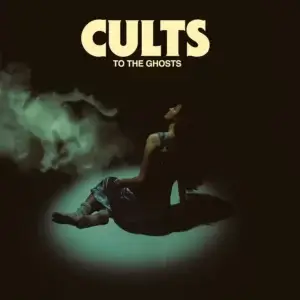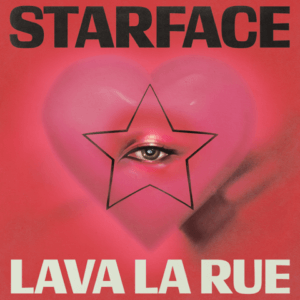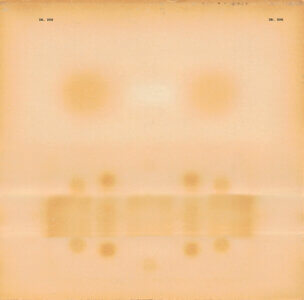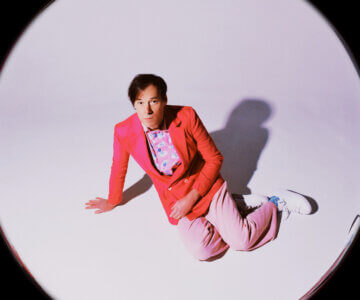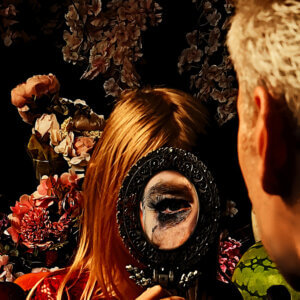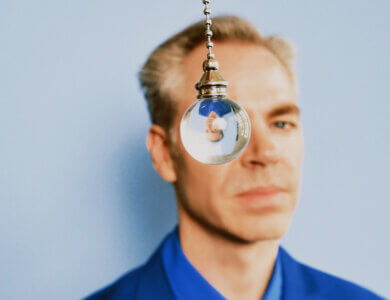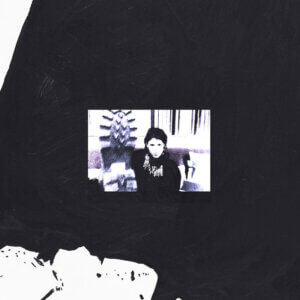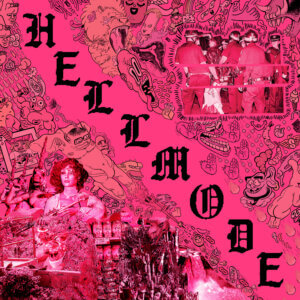LIES’ Nate Kinsella Explores Honest Musical Growth
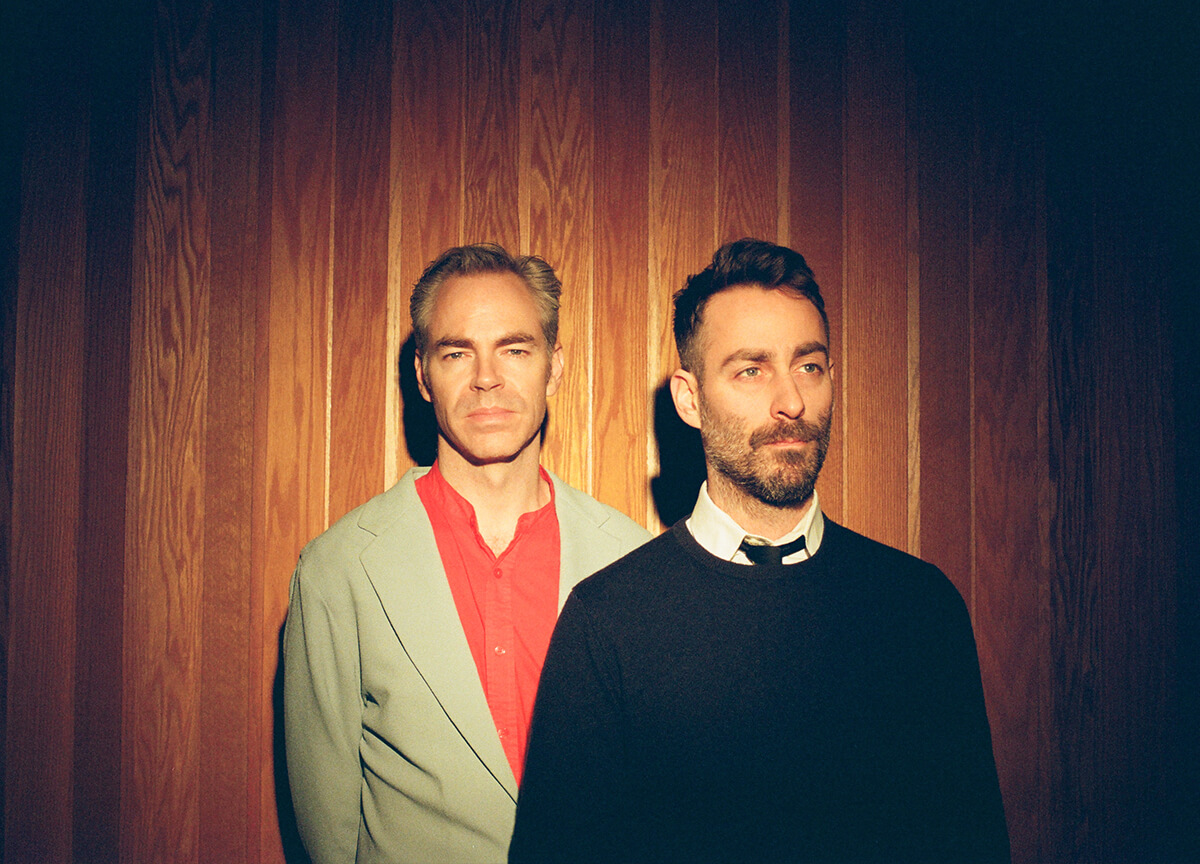
LIES multi-instrumentalist Nate Kinsella is reconfiguring how his body moves to the music.
Over the years, he’s contorted himself in various impressive fashions – he used to hammer at a drum kit while simultaneously working out quixotic Wurlitzer melodies in cult Chicago post-rockers Make Believe; more recently, he was mellow-malleting a vibraphone on the last album from beloved emo unit American Football. With LIES, his latest project with longtime collaborator and cousin Mike Kinsella, that range of motion has evolved yet again.
Behind the scenes, Nate discovered app-based synth tones with a swipe of a finger before building out the richest soundscapes of the project’s self-titled debut — technically formatted title-case as Lies. The video for the duo’s “Resurrection” likewise presented another fluid first for Nate: dancing in public. The playful vid finds he and Mike standing in front of a pair of mirrors, the neck-down view showcasing the graceful choreography of a pair of dancers standing on the other end of a soundstage. While generally obstructed, Mike and Nate mimicked the dancers’ movements, LIES’ limbs occasionally peaking past the borders of the mirrors.
“I don’t have a dance background — never took any dancing classes — [though] I think about body movement when I’m listening to or playing music,” Nate concedes to Northern Transmissions. While the act had previously explained in a press release that the “Resurrection” video was meant to illustrate “a kind of unselfconscious joy and freedom,” Nate confesses to Northern Transmissions that he still felt particularly vulnerable the first time he saw the finished video, nervously guarding his laptop screen as he streamed the clip from within a New York City coffee shop. “I have a hard time letting go, self-consciously, [of] how I look on camera. But that was taken off of my plate, a bit, because I was obscured for the most part. I had adopted somebody else’s image, which was fun!”
LIES’ self-titled collection still bears various Kinsella hallmarks — think American Football’s spangled six-string polyrythmia — but the record ultimately pushes the partnership into previously uncharted spectrums. From Depeche Mode-inspired synth beds, to Robyn-like lite-house bangers (“SummerSomewhere”), its impressive stuff made by indie veterans seeking out bold new grooves.
Speaking with Northern Transmissions, Nate Kinsella further details how he and his cousin — just a couple of rad dad emo gods — broke new ground with LIES.
This interview has been edited and condensed.
Northern Transmissions: There are similar tangents between American Football and LIES — those rich, polyrhythmic guitar layers; obviously Mike’s voice is a big connective piece; you’ve got Steve Holmes playing guitar on the album, too — so why did you decide to keep LIES its own thing, as opposed to fleshing the music out within the framework of American Football?
Nate Kinsella: We started these songs with Holmes and [American Football drummer Steve] Lamos. I had a batch of synthesizer snippets — little musical ideas — and I met up with Mike for a weekend and he threw some ideas on it. Then we were like, “I wonder how a synth American Football album would go
over?” But we approached the idea with trepidation; there are some people that are really into what that band sounds like, instrumentation-wise. I think we got away with adding vibraphone on LP3, but we were still dealing with acoustic instruments, for the most part. Once you get into synths, that changes the vibe.
And when we were writing all this stuff as American Football, we had to do it during the pandemic, which was super challenging. We were doing band practice Zoom calls; it didn’t work out. As soon as [Mike and I] decided that it could be a different thing, we were super untethered to instrumentation.
NT: Are these vintage synths you’re working with, or samples?
NK: Some of them were from an app that I had on my phone that was made by Propellerhead, the people who did Reason. They have an app called Figure where you mash your hand into your phone and the music always sounds really good. And some of it was VST [ed. Virtual Studio Technology]. I don’t actually own any synthesizers. Like, I guess I own the software that creates the sounds, but I don’t have any hardware.
It was a totally a new world to me. I would just sit down and flip through presets. I would spend no more than 30 seconds [finding synth tones], like, “Oh, that’s very Depeche Mode; what would Depeche Mode do with this? Ok, next!” Not a lot of emotional attachment.
NT: What can you say about a song like “Summer Somewhere,” which, percussively, brings you two into a lo-fi house direction?
NK: That was also [built] on that funny little app. From the get-go, it sounded like a Robyn song: melodic, bass-heavy, [with] the side-chaining kick drum effect. When the house kick comes in, it sucks down the music and you get this pumping effect. It sounds like it’s happening in a club. That was fun.
NT: Can we touch on LIES’ visual aesthetic? First off, is that a pelican on the album cover?
NK: I think it is!
NT: Considering there’s a song on the record called “Corbeau,” why not put a crow on the cover? For that matter, the single artwork for “Corbeau” featured a monkey. It’s like you’re throwing people off the scent.
NK: One of the threads that we decided to lean into [with our music] is that there’s a black-and-white side [to it], where it’s austere and serious. That part’s Mike; that’s just how I hear his approach in the music. And then all the stuff I would throw on exists in opposition to that — things that were more energetic and fluid. And fun! It might even make you laugh. They’re colourful and flowy.
Once we noticed [that, we thought] we should let that play out in the artwork as well. So, I took all these black-and-white photos of animals looking into the camera — serious! — and I would smear some paint over them, and that became the vibe.
NT: Has that always been the natural dynamic between you two, where you’re the goofier Kinsella?
NK: I don’t think so. I feel like that’s kind of new for me. With earlier albums — even the ones I made by myself — I just remember taking them very seriously. Everything was very painstaking. Within the past ten years, though, I’ve thought, “You know what? I’m not going to worry anymore.” I want to lift the weight; I don’t want to put more sandbags on myself. Even with the Make Believe stuff — the person playing those drum-and-Wurlitzer parts — there was just so much frustration. It seems like I was attacking everything from an angry place. I was an angry young man, and I look at it now like, “Oh, buddy…C’mon! It’s ok!”
NT: This is perhaps getting a little too navel-gazey, but despite the project’s name of LIES, is there a different kind of honesty you share with Mike — being cousins; literal family — than you might have with other musicians?
NK: Yeah, I think it’s a real special thing. We have a whole huge history together that we share.
NT: What the most brutally honest thing you’ve said to each other, at least in a musical sense?
NK: You know, we don’t really butt heads. I trust him to critique what I’m doing, and I think that he trusts my input, too. But I recorded all of his vocals, and there were times when I would just put some thoughts into his head about how to think about certain things. I don’t like to say no to people’s [creativity]; it feels unfair to have somebody come in and say, “I don’t like this.” What I feel is more productive is saying, “I was hearing this a different way. Have you thought about this approach to it?” Or, “Could we try one like this and see how it feels?” It’s like we’re doing a ton of costume changes when we’re trying out musical ideas. Like, “What about this scarf?” Ah…that doesn’t suit you that. “Ok, cool…I trust you!”
NT: Thinking some more on the dressing: there’s a significant, stylistic choice in making the band name all caps, while the album title isn’t. Typography matters! What’s the different in connotation between an all-caps lie and one that’s not?
NK: I think that’s open to interpretation, but I read this article that was about the street signs in New York, and how they were going to change them from all-caps to title case. There was this whole article about how that would change the feel of the city. When you’re in New York, it’s like, “Oh god, we’re on ATLANTIC, or BOWERY!” Every street sign is screaming at you. If you change it [to title case], it feels more polite. You’re offering the information rather than throwing it at somebody’s face. It changes how the text feels.
Anyways…album titles are tough. So, there really wasn’t one [in mind] to wrap it all up. Also, this wasn’t even going to be an album. It was originally going to be a series of singles. We weren’t really thinking of it as a whole. [Lies] seemed like an idea that was easy to sign off on. There wasn’t a whole bunch of meaning behind it.
NT: How has the experience of making Lies helped you move forward as songwriters?
NK: I feel like we both stepped out of our comfort zones quite a bit, and encouraged each other to do that, too. That felt liberating, because we’ve both been doing this for so long. I don’t want to speak for Mike, but I get the sense that he feels like he has to fit into a box sometimes. I really wanted to pull him out of that.
We’ve never made anything that sounds like this stuff; it’s ground we haven’t covered. Once you get through that process, it’s helpful for future projects. Like, I can be part of a song that has a four-on-the-floor, techno kick drum. That doesn’t feel strange anymore. This project has opened up the possibilities, which is really the most you can ask for.
NT: I want to close on something I read in the YouTube comments for the “Resurrection” video, specifically one person describing LIES as “just a couple of rad dad emo gods”. It’s a funny line, somehow both humbling and grandstanding you at the same time. How does that comment sit with you?
NK: That’s funny. How does that sit with me? I mean, that’s a nice comment; I’ll take that, for sure. That kind of made my day. There are a lot of comments that would ruin my day, which is why I never read them. Especially on that video — I didn’t want to know what anyone thought of seeing me in that way [i.e. dancing].
I mean, “emo gods” is a little over the top. You’re right, there’s a disconnect [between that and] a couple cool dads, [but] that comment is great. It all works together to build us up and tear us down at the same time.
Pre-order Lies by LIES HERE
Latest Reviews
Tracks
Advertisement
Looking for something new to listen to?
Sign up to our all-new newsletter for top-notch reviews, news, videos and playlists.


